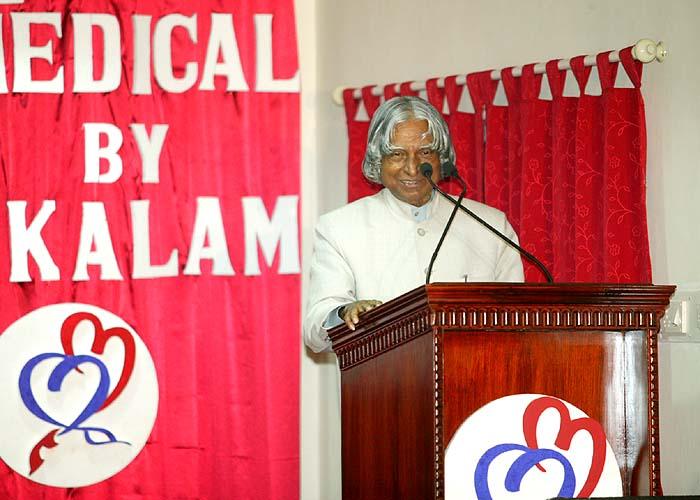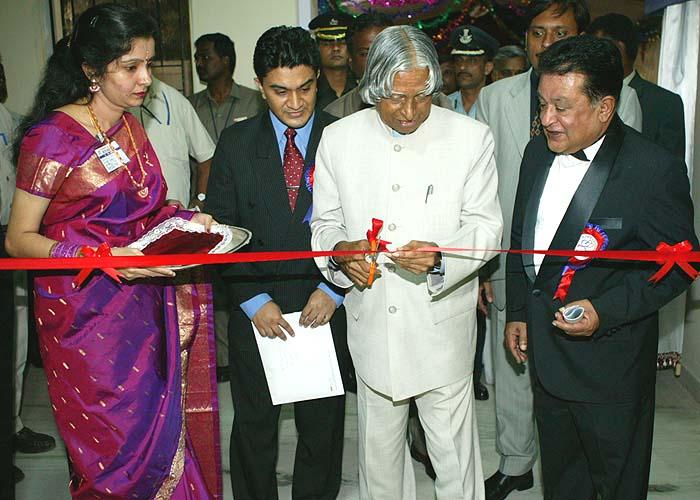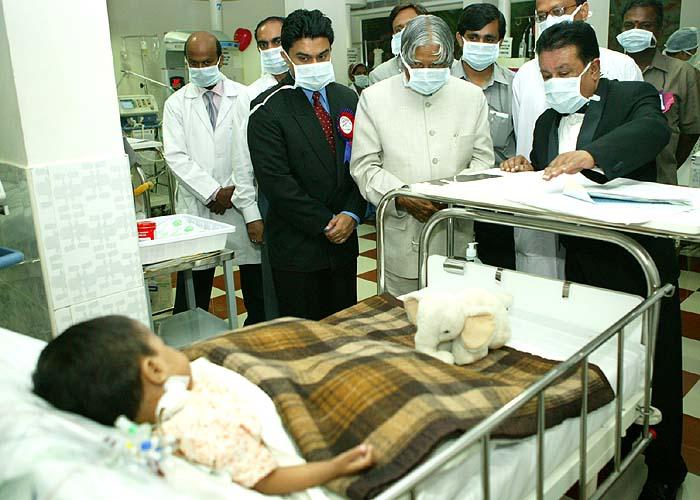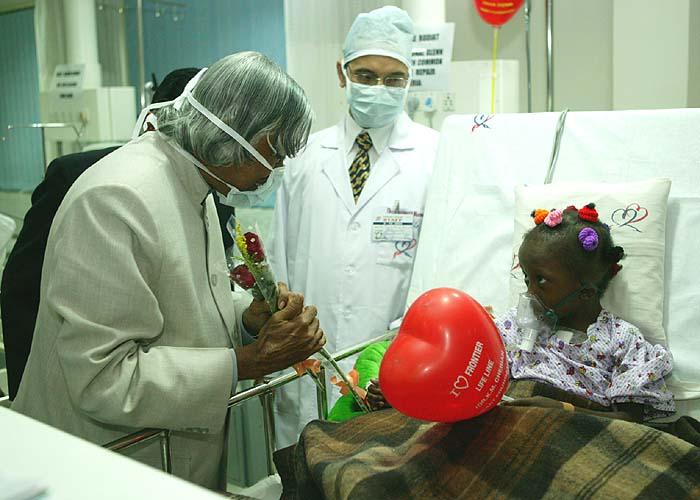Address During The Inauguration Of The International Centre For Biomedical Sciences And Technologies (Research, Training & Applications), Chennai
Chennai : 02-10-2004
Mission towards Healthy Hearts
I am delighted to participate in the inauguration of the International Centre for Biomedical Sciences and Technology (Research, Training and Application). My greetings to the surgeons, doctors, medical scientists and technologists, pharmacologists, distinguished guests and all the participants. Cardiac care is a vital healthcare area for Indian community. I am happy to note that this centre in collaboration with Manipal Academy of Higher Education, Bangalore, Sri Venkateswara Institute of Medical Sciences, Tirupati, Meenakshi Academy of Higher Education and Research, Chennai, Birla Institute of Technology and Sciences, Pilani and Indian Institute of Technology, Madras is planning graduate programmes in Bio-technology, Bio-Informatics, Bio-Medical Engineering, Genetic Engineering and Genetics. This Centre has a unique system of patient information system, which can be accessed by the relatives and friends of the patients admitted in this hospital for getting online information about the patients? condition. In this gathering I would like to discuss on the "Mission towards Healthy Hearts".
Heart has no Boundaries
Recently, three Indians along with other nationals were abducted in Iraq and India was making all our efforts to convince the abductors for getting them released. Around that time Dr KM Cherian wrote to me that, as an example of the sympathy and consideration which a common man in India has for the Iraqis by giving the example of twenty complicated open heart surgeries conducted on Iraqi children as early as February-march 2004 by the International Centre for Cardiothoracic and Vascular Diseases. He has done it merely out of human compassion. Much later, this information was provided to the concerned Ministry for using in the negotiation process with the abductors. This example shows that the noble medical profession does not see geographical barriers and every heart is the same for this community.
Rural Health Care
This Centre has established the first Cardiology and Cardiovascular Centre in the rural setup in the village of Parumala in Kerala which has a population of 8300. I am happy to note that the Centre had already carried out 300 angiograms, 25 angioplasties with stenting and nearly 100 open heart surgeries including children. This is a good rural development model where high quality healthcare has reached the remote villages and I am sure this facility can be extended as a medical tourism project to other villages in the country. This type of data and work done to the society should be utilized for realizing quality healthcare for the rural sector. At this stage let me narrate an example which touched my heart.
CARE for the hearts
In October 2002, I inaugurated the Care Hospitals telemedicine units at the G.B. Pant Hospital, Tripura, and I interacted with patients at different centers where I came across a 13 year old boy from Kailashar, Tripura. His parents are farm laborers and even a tiny piece of land they own was sold to provide medical treatment to this boy before CARE hospital diagnosed the problem of this boy. This boy was suffering from chronic rheumatic heart disease with severe mitral stenosis. His heart ailment was noticed three years ago, when he complained of breathlessness and chest pain. He was also coughing blood and lost weight, according to his elder brother Ismail Ali. Doctors at Agartala found that his condition was serious and needed specialized treatment which was expensive. He discontinued his studies as he couldn?t take the strain of walking down to the school or even play around with the other kids. He was taken to the CARE Hospital at Hyderabad, and was treated by Dr. B. Somaraju and Dr. Raghava Raju who carried out the balloon dilatation. The entire treatment and travel expenses were borne by the hospital. The boy?s condition is being continuously monitored and he is doing fine. He has also started going to school. CARE foundation has recently started a ?Little Hearts Foundation? through voluntary contributions made by philanthropists. They have so far carried out 58 heart operations on children.
Now I would like to discuss some of the leading research areas.
Research Areas
Animal experiments have shown that stem cell can be coaxed to become nerve cell and nerve cell to become a muscle cell. It has also been learnt that the stem cell seems to go preferentially to injured tissues when introduced in an animal. These findings are useful for treating diseases where cells are damaged or malfunctioning and require replacement. Parkinson?s disease, juvenile diabetes, stroke, spinal cord injuries, and mental retardation in children may find cure through this treatment. Prof. Venugpal has done for treatment of diseased hardened muscles of heart. .
Line of Treatment for Parkinson?s Disease
I would like to share with you the research work done by Prof Vijay K. Vardan of Pennsylvania State University, U.S. He shared with me the possible line of treatment for Parkinson?s disease and Epilepsy. The primary symptoms in Parkinson Disease as you all aware are tremor or trembling in hands, arms, legs, jaw, and face, rigidity or stiffness of the limbs, slowness of movement and impaired balance. Prof Varadan has devised a wireless system for monitoring and control of Parkinson?s disease. The system consists of an implantable DNA insert in the head region for generating a pulse to the nerve system; controlled either by a modified pacemaker or smart hat. Passive polymer based gyro sensors are implanted in the tremor location. The sensor gets the power from the Pacemaker and the Pacemaker then reads the tremor motion. The Pacemaker then generates the pulse in the implanted device in the head to control the tremor. This appears to be a promising line of treatment for such diseases. Prof. Varadan also has reported that the few patients affected by Parkinson diseases had a full recovery. I would suggest that this International Centre can work with Prof. Varadan?s group for evolving solutions for Parkinsons disease through collaborative research.
Development of Heart Valves
Open heart surgery to replace the diseased heart valves with prosthesis has become a common modality for treatment. Recent research has brought out bio-prosthetic heart valve implants and has been found successful in clinical trials. This is the promising area of research in view of the cost consideration and also due to anti-coagulation properties. Another area of research is development of cardiac homograft. Also, there is a need to standardize the homograft and genograft through decellularisation procedure which may eventually lead to the development of autografts. I am happy that the Centre will be progressing research in all these front line area of research. I would suggest that this Centre can work in collaboration with All India Institute of Medical Sciences, Delhi, Sri Chitra Tirunal Institute for Medical Sciences and Technology, Thiruvananthapuram and other leading medical institutions in the country.
Affordable medical technologies
The convergence of bioscience and IT into Bioinformatics has given the thrust to researchers for genomics-based drug discovery and development. Pressure is mounting over the pharmaceutical companies to reduce or at least control costs, and have a growing need for new informatics tools to help manage the influx of data from genomics, and turn that data into tomorrow's drugs. Indian IT industry has a tremendous opportunity in the drug development.
In computational biology the most expensive investment is in the software for drug analysis, modeling and design. These investments at times are of the order of several hundreds of thousands of dollars and thus the computational biology had gone beyond the reach of many colleges and universities and also small scale startups. However many academic institutions including the Indian Institute of Science and CSIR laboratories have already built-up the capability to develop the software, but nevertheless lacked the infrastructure to covert this software into a product. The New Millennium Indian Technology Leadership Initiative (NMITLI), the CSIR had pioneered the efforts to develop a world class software package called Bio-Suite using TCS one of our software industry and academic institutions. Bio-Suite is a state-of-the-art software package that caters to all aspects of computational biology from genomics to structure-based drug design. It incorporates the latest publicly known algorithms, as chosen by our panel of academic partners, and has been coded entirely by the Indian software team, using the best software engineering practices. It can be used by academic and R&D institutions, small/medium biotechnology companies at an affordable cost but with the functionality of well known world class software. I would suggest the International Centre for Biomedical Sciences and Technology (Research, Training and Application) make use of this and contribute for the further development in this direction.
I note that most medical equipments have considerable component of computers and peripherals whose cost has been plummeting in the open market. But, the cost of medical equipments and the services have not been coming down at the same pace as we see in ICT. India is well poised with its excellent ICT and healthcare base to work towards a world cause to make modern services such as MRI, CT Scan and others, affordable by the poor. The specifications and acceptance standards for these equipments and services can be laid down by an expert committee. They can also ensure that the regulations and clinical validation procedures do not become a hindrance instead help in getting these products developed and marketed in a time bound manner. This will open up the entire world market to Indian products.
Career Plan for Physician Assistants
The International Centre for Biomedical Sciences and Technology?s training wing will be generating a cadre of physician assistants who will be a vital professional link between the doctors and paramedics. These personnel will be extremely useful for promoting healthcare delivery system in the rural areas. This Centre should create a growth plan for this Cadre by enlarging their scope of work in research areas with their innate clinical experience so that they can eventually aspire to become scientists. This will need discussion in a common forum of institutions where similar training facilities are being offered. With this model, it is essential to build education and employment generation in the rural sector.
Conclusion
We need good hearts to treat the ailing hearts, we need helping hands to remove the pain, and we need beautiful minds to give happiness to the patients. In this context, I would like to recall a poem. I would like to share with you the essence of it.
When God first created the human being, it took million and millions of years to get the right shape. He went on experimenting and finally he realized the shape he wanted. Once realized, he gave life. First the man said, ?I thank you, Almighty. Second thing he did, he smiled at God. Almighty was very happy, that his creation has done two good things. Then, God was preoccupied for some time, later when God looked at the man and found something is missing in him. He created the fire in milli-seconds and created Shaitan out of fire. He asked Shaitan to prostrate before the first human being that he created in his image. The Shaitan refused to prostrate. He said, ?Oh! Almighty you have created me out of fire, I am a superior creation?. The God was taken aback. He thought for a while and decided to integrate the man and Shaitan into a one single system, that is the human race what we are. If we want to become close to Almighty God, let our mind and hand be kind to human beings who are suffering with pain. That means we have defeated the Shaitan within us. The question is who will defeat whom? May God bless you to be close to God?s image and the Shaitan gets defeated. Your kindness will flow through your actions, thousands and thousands of patients will be relieved of the heart pain and they will say ?Thank you doctor? with the smile. That means you are in God?s image.
I wish you all the best.




